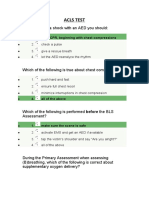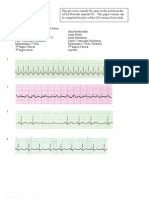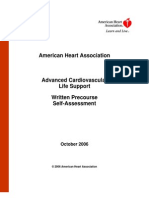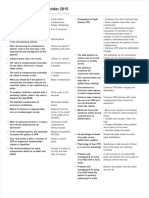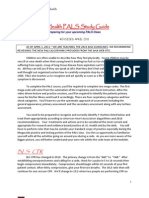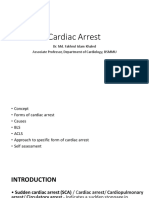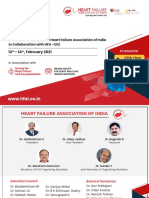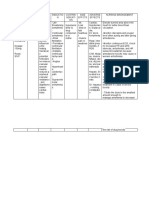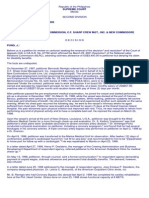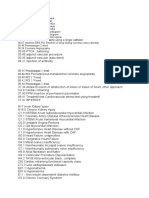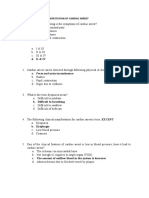2021 ACLS Study Guide
This packet has been developed to supplement the virtual learning process
In order to enter an ACLS class, the following certificates must be brought to class.
(www.elearning.heart.org/courses ‐ Click on “Precourse Self ‐Assesment AND Precourse Work”)
There will be an expectation of self‐study prior to class!
You will complete the pretest and then be directed to do the Precourse Work to view the
videos
Common Code Team Considerations
CPR‐
people still off chest more than 10 seconds. Everyone at the bedside can
watch timing during switches.
Oversight –
Need to follow the current ACLS/ PALS guidelines and algorithms. Code
carts have the AHA guidelines on the carts. These are science based
international guidelines!
Empowerment
Nurses can do more awaiting the code team. Great job recognizing patient
response, activating the code team and starting CPR.
Back board under patient; apply AED pads; push AED analyze button; set up oxygen and
suction
Too much Epinephrine ‐ Slow down!
Pharmacologically: Epinephrine is 1mg IV every 3‐5 min.
Clinically: drugs administered after switch, rhythm ID, Defib, start CPR and
push drug with flush‐ so every 4 minutes.
Too much Sodium Bicarbonate and Calcium Chloride
Sodium Bicarb: only if acidosis presented with history
Acidosis – DKA, Dialysis, prolong downtime, prolonged respiratory
compromise. Weight driven‐ give it right! 1meE/kg‐ subsequent doses are
0.5mEq/kg based on ABG results.
Calcium Chloride
Hyperkalemia, calcium channel blocker overdose
NOT PEA or ran out of things to do.
1
� TEACHING STATIONS
SCENARIOS- GENERAL NOTES
What to do immediately when code team arrives–
Establish Team Leader
Determine patient weight – documented or estimated. This will allow all
drugs to be given consistently.
Determine glucose level – accu check when IV established.
Peripheral IV first choice – then intraosseous but don’t delay IO in cardiac arrest
During code – push all drugs rapidly at beginning of 2min cycle and follow with 20 ml – CPR
will help circulate!
MET/ RRT- identify and treat early clinical deterioration
Defib – immediately resume chest compressions
Team concept – close loop involves repeating orders
Debriefing post code
Clearly designate tasks/roles
Knowing one’s limits – ask for another task
Address mistakes immediately
H/T: treatable causes:
Hypovolemia, Hypoxia, Hydrogen ion (acidosis), Hypo/Hyperkalemia,
Hypothermia
Tension pneumothorax, Tamponade (cardiac), Toxins (include
hypoglycemia), Thrombosis (coronary), Thrombosis (pulmonary)
Start looking at treatable causes at beginning of code – all should be
documented (i.e. Hypoxia- ventilating effectively; Hypovolemia- fluids
running)
Symptomatic/ Unstable: chest pain, shortness of breath, change in level of
consciousness, drop in BP, signs of CHF
2
� 3
�2020 Science Summary Table
This table compares 2015 with 2020, providing a quick reference to what has changed and what is new in the
science of advanced cardiovascular life support.
Table. Topical Comparison of 2015 and 2020 ACLS Science
ACLS topic 2015 2020
1 breath every 5 to 6 seconds for • 1 breath every 6 seconds for respiratory arrest with
respiratory arrest, with a bag-mask device or without an advanced airway and also for cardiac
arrest with an advanced airway (use this rate with a
Ventilation 1 breath every 6 seconds for ventilation
bag-mask device if your local protocol is continuous
with an advanced airway in place
compressions and asynchronous ventilations for
cardiac arrest)
• Atropine dose: 0.5 mg • Atropine dose: 1 mg
Bradycardia
• Dopamine dosing: 2 to 20 mcg/kg per minute • Dopamine dosing: 5 to 20 mcg/kg per minute
Synchronized cardioversion initial
recommended doses:
– NarrowQRScomplex,regularrhythm:
50to100J Follow your specific device’s recommended
energy level to maximize the success of the
– NarrowQRScomplex,irregularrhythm: first shock
Tachycardia 120to200J Wide QRS complex, irregular rhythm:
defibrillation dose (not synchronized)
– WideQRScomplex,regularrhythm:100J
Wide QRS complex, irregular rhythm:
defibrillation dose (not synchronized)
Post–Cardiac
• Titrate oxygen saturation to 94% or higher • Titrate oxygen saturation to 92% to 98%
Arrest Care
• 6 links for both chains (in-hospital cardiac arrest
Adult Chain • 5 links for both chains (in-hospital cardiac arrest
and out-of-hospital cardiac arrest): added a Recovery
of Survival and out-of-hospital cardiac arrest)
link to the end of both chains
• IV preferred over IO access, unless IV fails (then OK
IV/IO Access • IV access and IO access are equivalent
to proceed to IO)
ACLS topic 2020
Epinephrine 1 mg every 3 to 5 minutes or every 4 minutes as a midrange (ie, every other 2-
minute rhythm check)
Amiodarone and lidocaine are equivalent for treatment (ie, either may be used)
Added maternal cardiac arrest information and algorithms (in-hospital)
Cardiac
Added ventricular assist device information (left and right ventricular assist device) and
Arrest
algorithm
Added new prognostication diagram and information
Recommend using waveform capnography with a bag-mask device
• Revised stroke algorithm
• New stroke triage algorithm for EMS destination
Stroke
• Focus on large vessel occlusion for all healthcare providers
4
� • Endovascular therapy: treatment window up to 24 hours (previously up to 6 hours)
• Both alteplase and endovascular therapy can be given/performed if time criteria and inclusion criteria
are met
• Consider having EMS bypass the emergency department and go straight to the imaging suite (computed
tomography [CT]/magnetic resonance imaging); initial assessment can be performed there to save time
• Titrate oxygen saturation to >94%
The 2020 AHA guidelines have added a sixth link to the Adult Chain of Survival diagrams for
out of hospital cardiac arrest (OHCA) and in hospital cardiac arrest (IHCA). The sixth link,
recovery, focuses on evaluation, intervention, rehabilitation and support.
RESPIRATORY EMERGENCIES
Open Airway- head tilt, chin lift
OPA- corner of mouth to angle of mandible
BVM ventilations- need to work on this skill! Think 3 step usage (seal the mask,
open the airway, squeeze bag ONLY enough to cause the chest to rise). Good BVM skills
can delay the need of intubation.
Advanced Airways (ET) – experts to insert.
Capnography
Monitor capnography when patients are intubated
<10mm Hg – chest compressions may not be effective
10-20mm Hg- ventilating effectively
35 to 40 mm Hg- Post cardiac target range
Purpose for intubated patients- allows monitoring of CPR quality
Continuous waveform capnography- Reliable method to confirm and monitor ETT
Breathing/ ventilations
Rescue breathing with pulse – 1 breath every 6 sec (10/min)
Re-evaluate pulse every 2 minutes!
Excessive ventilations -> decreased cardiac output due to increased intrathoracic pressure
SpO2 > 99% / high flow-> oxygen toxicity
Pulse ox < 94%- apply high flow oxygen
AGONAL GASPS (no breathing or ineffective breaths) will likely be an indicator of cardiac a
arrest in the unresponsive patient
Hyperventilation – measurable- 20 bpm adult; 25 bpm- peds – re-evaluate every 2 minutes.
5
� VF/Pulseless VT – “Shockable”
6
� Pulseless Torsades
same treatment as above but consider magnesium sulfate 1-2 Gms. (defib 3) and consider
lidocaine 1- 1.5mg/kg IV (defib5)
PEA/AYSTOLE – Non-shockable
PEA- organized rhythm with NO pulse (Problems, Epi, Assess). VT is a shockable rhythm and
has its own algorithm.
CPR, Epinephrine 1mg IV( give as soon as drawn up, flush and CPR 2 minutes, start
considering H/T
Switch compressors CPR 2 minutes, considering H/T
Switch compressors -Epinephrine 1mg IV, flush and CPR 2 minutes,
Continue H/T
Switch compressors CPR, 2 minutes, considering H/T
Switch compressors -Epinephrine 1mg IV, flush and CPR 2 minutes,
Continue H/T
Asystole – CPR, epinephrine –
NO ATROPINE
Same routine as above
7
� Tachycardia with a pulse
8
� 9
� BRADYCARDIA
Asymptomatic – conduct problem-focused history and exam
Symptomatic – consider Atropine 0.5mg IV every 3-5 minutes to 3 mg.
These 3 interventions are given equal weight - Transcutaneous Pacing –
Chronotropic drips - (Epinephrine – 2-10 mcg/min or Dopamine- 2-20 mcg/kg/min)
Consider treating hypoxia before drugs- Simple before drugs and electricity
10
�BLOCK REVIEW
Sinus Rhythm with 1st degree AVB
PRI > 0.20 sec
Progressive lengthening of PRI til dropped QRS
2nd degree type 2 AVB
Constant PRI when associated with QRS
3rd degree AVB
Dissociation between atria and ventricles
Constant P to P interval; Constant R to R interval; PRI vari
11
� ACUTE CORONARY SYNDROME
All Cardiac Complaints should consider:
Oxygen, Monitor, IV, 12 lead EKG
MONA- Oxygen, Aspirin (160-325 mg-no longer needs to be no-enteric coated)
Nitroglycerin (have ECG findings), Morphine
Before Ntg – Assess for phosphodiesterase use, ie. Sildenafil; check for RV dysfunction /
inferior wall STEMI- (preload/hypotension)
STEMI- door to balloon -90 minutes; door to needle – 30 minutes
EMS- consider PCI designation of out of hospital ROSC.
12
� ACUTE ISCHEMIC STROKE
EMS- consider appropriate facility even if delay and alert them prior to arrival
Stroke assessment scale (FAST)- FACE / ARM/ SPEECH/TIME)
Non contrast CT of head WITHIN 25 MINUTES ARRIVAL TO ED
Start fibrinolytic therapy
within 1 hr. of hospital arrival
3 hrs. up to 4.5 hrs. in select patients from onset of symptoms
4.5-6hrs from onset of symptoms- interventional
13
� POST CARDIAC CARE – ROSC
Take prehospital patients to appropriate PCI facility
AIRWAY- consider intubation as needed (rescue breathing with pulse is
1 breath every 6 seconds)- 10 breaths/ minute, CAPNOGRAPHY
PERFUSION-
Minimum systolic BP – 90mm Hg
Raise with fluids – 1-2 L. NSS THEN
Pressor drips – Epinephrine (0.1-0.5 mcg/kg/min)
Dopamine (5-10 mcg/kg/min)
Norepinephrine (0.1-0.5 mcg/kg/min)
TARGETED TEMPERATURE MANAGEMENT (TTM)
No verbal response
TTM- 32-36 C - for 24 hours once target temp is obtained and
AVOID fever – causes poor neurological outcomes
Rapid infusion of cold fluids prehospital is not recommended.
FOLLOW-UP/ RECOVERY (new 6th step)
. NOW consider ABG, labs, repeat 12 lead ECG, bed assignment, xrays
. Coronary angiography should be performed emergently for all cardiac arrest with
suspected cardiac causes of arrest.
. Neuroprognostication Consideration (typically at least 5 days after ROSC treated
with TTM ~72 hrs after normothermia) patients remaining comatose after CA,
multiple modalitites should be used to improve decision-making accuracy. (assessing
level of consciousness, neuro exams, clinical exams (pupils, corneal reflexes), EEG,
neuroimaging (gray-whtie ratio, restricted diffusion on brain MRI, reduee apparent
diffusion coefficient (ADC) on the brain MRI.
. SURVIVORSHIP After Cardiac Arrest- assess anxiety, depression, PTSD, fatigue.
Multimodal rehabilitation assessment
Discharge planning for patient and caregivers
Debriefings and referrals for emotional support
Steps for Survivor, family and community
Recognition /activation of EMS
Immediate high-quality CPR
Rapid defibrillation
Basic and Advanced EMS
Advanced post-arrest care
Healing and Recovery
14
� 15
�
OPOID Associated Emergency
16
� CARDIAC ARREST IN PREGNANCY
17
�
18
�
19
� COURSE COMPLETION REQUIREMENTS
www.elearning.heart.org
PRECOURSE SELF‐ASSESSMENT AND PRECOURSE WORK.
Do not just do the self‐assessment!
****. Be sure to bring the course completion certificate ‐ print (or screen shot!) ******
Material review/ teaching stations
Adult 1‐rescuer CPR with AED Infant 1‐2 rescuer CPR
BVM‐ rescue breathing (adult and infant) Obstructed Airway – adult and infant
MegaCode 50 question Written examination exam
84% is Passing
20












